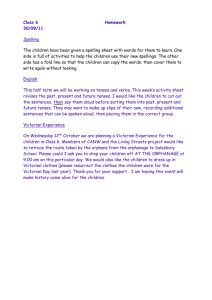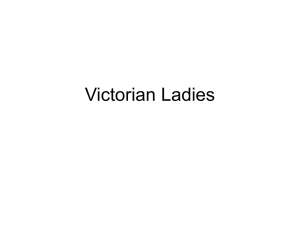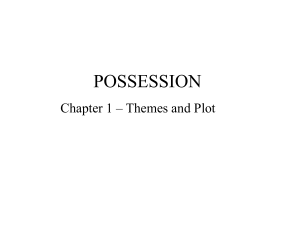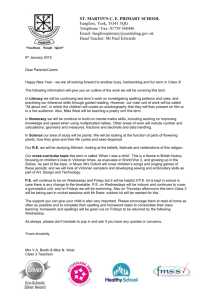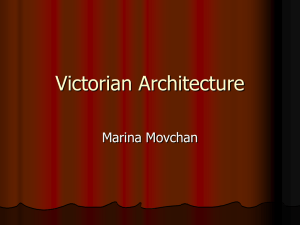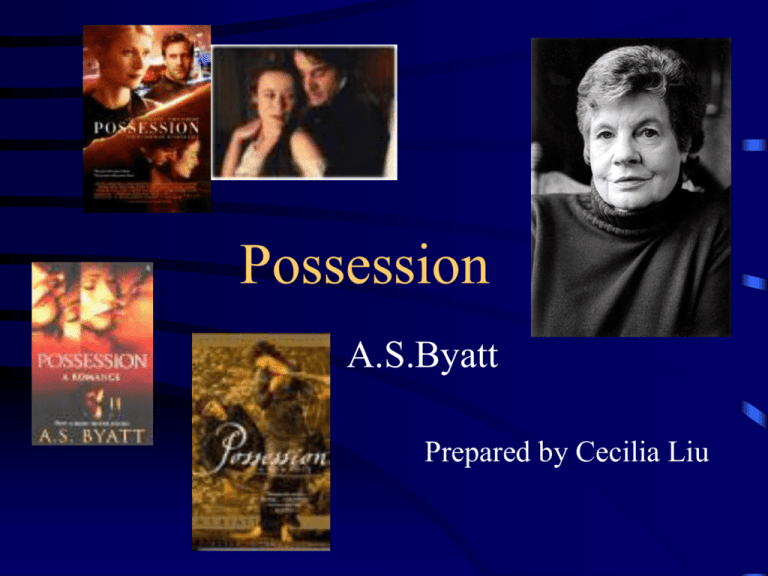
Possession
A.S.Byatt
Prepared by Cecilia Liu
A. S. Byatt
• English novelist Antonia Susan Byatt has
been described as a "postmodern Victorian."
• Educated at York and at Newnham College,
Cambridge. She taught at the Central School
of Art and Design and was Senior Lecturer in
English and American Literature at
University College, London, before returning
to full-time writing in 1983. A distinguished
critic as well as a novelist, she was appointed
a C.B.E. in 1990.
A. S. Byatt
• Her novel Possession won the Booker Prize
and Irish Times/Aer Lingus International
Fiction Prize in 1990. Her other fiction
includes Babel Tower, Angels and Insects,
and The Djinn in the Nightingale's Eye. Her
critical works include Degrees of Freedom,
a study of the novels of Iris Murdoch, and
Passions of the Mind (selected essays).
“Fictional Realism”:
Parallel Narrations
• The reader as character
• Two literary historians
--Roland Michell and Maud Baily
• Two Victorian poets' relationship
-- Randolph Henry Ash and Christabel LaMotte
• Christabel & Maud
• Randolph & Roland
• Randolph & Ellen
Roland & Val
• Christabel & Blanche
Maud & Leonora
Mirror-games and Plot-coils
• the modern day plot
• the plot of the Victorian poets
• the two modern day literature historians
unearth the secret passion between Ash
and LaMotte, their own lives begin more
and more to mirror the plot of the
Ash/LaMotte correspondence.
Posession and Seeing Double
• Possession is a work of double vision, telling
a story within a story, as well as being in itself
a book about books.
• Byatt thus refers in her work to three nonintersecting worlds—that of the reader
reading the book, that of Roland and Maud
researching Ash, and that of Ash falling in
love with Miss Lamotte—asking us, even if
only implicitly, to find the parallels between
them.
• Scholarship and art
Solitude and Secrecy
• A journey of discovery
• Solitude plays a substantial role not only
between Roland and Maud, Ash and LaMotte.
• the connections between various documents
and characters suggest that isolation and
solitude which is often desired by Christabel
and Roland is difficult to obtain and maintain.
(Ch 11, 196; Ch12, 215)
"Follow the Path:"
obsessive investigation
• Maud and Roland spontaneously decide to
recreate Ash and LaMotte's trip to Yorkshire.
• They "follow the path" (238) of the Victorian
poets in three ways. They retrace the steps of
Ash and LaMotte's trip, intentionally, and,
when they visit a place called Boggle Hole,
unintentionally. They continue along the trail
of clues that suggests an affair between the
poets. And Maud and Ronald move closer to
a romance as brash as that between Ash and
LaMotte.
Gold and Green: The Colors of
Beauty and Desire
• Maud Bailey: a serious scholar dedicated to
the study, particularly from a feminist
perspective, of the fictional poetess
Christabel LaMotte.
• Roland Michell, a literary scholar and the
protagonist of Possession, discovers that
Randolph Henry Ash, the poet of his interest.
• Roland & Maud’s first meeting (38-39)
"An Empty Clean Bed : "
Whiteness, Desire and Fear
• Whiteness signifies both purity and
desire, a paradox the novel both
struggles with and values.
• Roland Michell and Maud Bailey, find a
common desire in the absence of desire:
the image of a clean, empty white bed.
[Ch14, 267]
Possession and The Lady of Shalott
• LaMotte compares herself to the Lady of
Shalott in Chapter 10 (187)
• The Lady of Shalott sits perpetually with her back
turned to the world, weaving the reflections of the
outside world she sees in her mirror. Becoming
"half sick of shadows" the Lady of Shalott "left the
web, left the loom" and embarks upon a journey
into the world. But going out into the world proves
poisonous, and as she floats "down to Camelot,"
the Lady dies. (As a poem coming out of Victorian
England, her death speaks what might happen to
the angel in the house if it decides to spread its
wings.)
'I am Half-Sick of Shadows'
The Lady of Shalott, painted
by John William Waterhouse
The Lady of Shalott was a
favorite subject of many PreRaphaelite artists. Written by
Alfred Lord Tennyson, The Lady
of Shalott is a story where
passion for life evokes death.
The the poor Lady of Shallot is
cursed to never look directly out
of her window. She may,
however, view the world by
looking into a mirror.
Image: http://www.nouveaunet.com/prbpassion/med1.cfm
In her passion,
she forgets the
curse and
looks down
toward
Camelot to
catch a
glimpse of
Lancelot. The
mirror cracks
and the curse
comes upon
her.
• The Lady of Shalott goes down to the riverside and finds a boat. She unties
the boat and lies down. As she floats down the river toward Camelot, she
sings a song. Her blood freezes to her cold death.
Possession and Aurora Leigh
• Similarly, in the first part of Aurora Leigh,
Aurora insists on being left alone to her writing,
and cannot be bothered with her suitor, Romney
Leigh. She does not, however, maintain this
conviction, and in the end of the lengthy poem
believes in the power of love as much as the
power of her own writing. In this particular letter
written by LaMotte, she seems to regard Ash,
and the outside world entire, as a threat to her
poetry. Yet in Possession, like in Aurora Leigh
and The Lady of Shalott, LaMotte does not
remain shut up, but continues a correspondence
and relationship with Ash.
Aurora Leigh (1856)
• A novel-poem by Elizabeth Barrett Browning (18061861)
• Aurora: "the dawn"
• It describes Aurora's successful rebellion against her
conventional Victorian English childhood; to travel in
Italy, find love, and pursue her career as a writer.
• She rejects her cousin, Romney Leigh, in favor of her
own vocation as a poet. Romney then decides to marry
a lower-class woman, Marian Earle.
• But Marian is sent away to France. Trapped and raped,
she becomes pregnant. She and her child are later
rescued by Aurora. The three set up a home together in
Italy, where Romney later appears.
Aurora Leigh (1856)
• He had been blinded by an accident and has become
somewhat softened by experience. Meanwhile,
Aurora has learned the value of love from living
with Marian and her child. She marries Romney in a
new spirit of modest self-effacement. While not
giving up poetry, she will write in service to the
ideas of her husband.
• Browning closes with a compromise between the
artist's drive for self-expression and the Victorian
wife's role of submissive service.
• Source: http://www.vanderbilt.edu/AnS/english/English151W03/auroraleigh.htm
Aurora Leigh‘s Dismissal
of Romney- (The Tryst)
by Arthur Hughes (1832-1915)
Oil on canvas (1860)
Tate
Gallery
• The subject of this picture
is taken from Elizabeth
Barret Browning's poem
Aurora Leigh, which was
first published in 1856.
The scene depicted is the
moment at which Aurora,
who aspires to be a poet,
is courted with a marriage
proposal by her cousin
Romney. Rejecting his
offer she proclaims her
own `vocation'.
• Image:
http://freespace.virgin.net/k.pea
rt/Victorian/hugheslove.htm
Christabel as Melusina
• In French mythology, Melusina, or Melusine, was a
water-sprite related to the Dames Blanches (the white
ladies). The Melusina legend became extremely popular
during the middle-ages, especially in the northern regions
of France. In the early 1500s, Jean d'Arras, a French
historian, received orders from the Duke of Berry to
record all the information he could gather on Melusina.
Jean d'Arras spent a number of years researching and
collecting material for his major work, Chronique de
Melusine. Much of his research was indebted to William
de Portenach's previous chronicles on the history of
Melusina.
• Source: http://www2.sjsu.edu/depts/jwss.old/possession/fr-essay.html
The Framework of the Melusina Myth
• According to Baring-Gould, the structure or the
framework of the Melusina story is based on a
mythical archetype involving mortal men and
supernatural women. The general framework can be
broken down as such:
• A mortal man falls in love with a woman of
supernatural contest.
• She consents to live with him, subject to one
condition.
• He breaks the vow and loses her.
• He seeks her, and a) recovers her; or b) never
recovers her.
• The Melusina myth fits this model with one exception:
Raymond never recovers Melusina.
• Melusina (33, 116-17, 333): In Breton mythology, a
lamia, one of the legendary White Women (Dames
Blanches), having the upper body of a human female
and the lower body of a serpent. Magically masking
her true form, Melusina married the wandering knight
Raimondin under the prohibition that he never view her
on Saturdays. Raimondin broke the taboo and witnessed
his wife bathing in her snake-form. He confronted her
and she fled after transforming herself into a dragon. In
later myths, this same dragon became a harbinger of
doom for the Bretonnian nobility, haunting castles
wherein someone was doomed to die.
• Christabel LaMotte's “The Fairy Melusine” (Ch 16, 28998)
http://www.lincolnshirelife.co.uk/PAGES/BACK_OCT
_2002/POSS.html
No Discernible Trace
• Love letters, poetry, journal entries, and
other written forms further the story
along throughout the novel to its very
end.
Critiques of Romantic
Inspiration in the Poetic Form
• Like Elizabeth Barrett Browning's
Victorian novel in verse, Aurora Leigh,
A.S. Byatt addresses the role of the
poet, using references both to the
nature of love and the essence of
creative inspiration itself, in her work,
Possession.
• Utilizing the context of letters between a
renowned 19th century poet and his
lover, a lesser known female poet, Byatt
examines the substance of poetry in a
non-poetic form. As a modern author,
Byatt places this narrative in the
Victorian time period in order to
legitimize a critique of Victorian notions
of poetry, artistic philosophies that are
espoused in Barrett Browning's work.
Idea of poetry as an
expression of generalized love
• Ash depicts the contemporary trend of
viewing poetic inspiration as originating
from the state of general human love,
where all-encompassing passion is
"masked" by the particular intercourse
of a lover and his love. [Ch8, 132]
• In his critique of the forms of poetry in
his time, Randolph Henry Ash presents
Christabel with a divergent notion of the
relationship between love and poetry
and additionally, suggests that love is in
and of itself a less admirable form of
inspiration than another type of human
relationship, the rapport of friendship
A Critique of the Victorian
Omission of Sexuality
• In her depiction of the Victorian past, Byatt
recognizes Victorian culture's elision of all
discourse surrounding sexuality. Byatt depicts
Victorian marriage--represented by the poet
Randolph Ash and his wife Ellen--in the same
way a Victorian would have represented it, as
evacuated of sexuality. Yet one of Byatt‘s
projects in Possession is to examine the
sexual act in Victorian marriage. [458-59,
460]
Marriage between
Randolph and Ellen
• characterized by its lack of sexual
intimacy
• Ellen: the sexual act is a brutal
experience, incompatible with marriage.
Marriage, according to Ellen Ash's
construction of it, is frightening, close to
a master-slave relationship.
• typical Victorian notions of female
sexuality and marriage.
A critique on the utility of modern
theories of sexuality
• In contrast to the Victorians‘ omission of
discourse concerning sexuality is the
twentieth-century’s hyper-theorization and
discussion of it. Maud and Roland recognize
this as they search for clues together. [253]
• Byatt: twentieth-century fascination with
sexuality and sexual theorizing is equally
limited.
• critiquing both the Victorian system, with its
omission of sexuality, and the modern one,
with its intense analysis of sexuality.
Imperialism—Cultural and
Otherwise—in Possession
• Possession engages in various questions
of ownership: Who is entitled to Roland's
initial discovery and its aftermath? What
does it mean to possess another person in
a romantic relationship? Do Roland and
Maud have a right to enter Mrs. Irving's socalled private garden in their own backyard?
and so forth.
Cultural Imperialism
• One of the most important issues
throughout the novel is the idea of
cultural imperialism, as Leonora Stern
and others term it, and the disputes
which arise over whether the
correspondence should remain in
Britain based on the fact that its authors
were British. (Ch 20, 403-4)
References
• A. S. Byatt's Possession
http://www2.sjsu.edu/depts/jwss.old/possession/
• Byatt, A. S. Possession: A Romance. London: Vintage,
1991.
• Color and Identity in A. S. Byatt’s Possession by Stephen
Dondershin
http://www2.sjsu.edu/depts/jwss.old/possession/fr-essay.html
• Aurora Leigh (1856)
http://www.vanderbilt.edu/AnS/english/English151W-03/auroraleigh.htm
• MELUSINA myth: Origins of Christabel LaMotte's "The
Fairy Melusine"
http://www2.sjsu.edu/depts/jwss.old/possession/fr-essay.html





